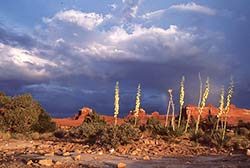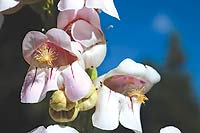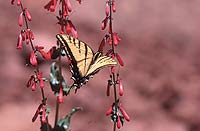 There is something magical about a wildflower. Perhaps it’s the contrast of the delicate blooms set against an ancient sandstone backdrop. Maybe it’s the dependency on available moisture for seeds, long dormant in the soil, to awaken from their slumber and erupt in spectacular displays carpeting the desert landscape. Or, could it be the relationship between flower and pollinator, honed over thousands of years, to provide unique transfers of pollen grains from one flower to another.
There is something magical about a wildflower. Perhaps it’s the contrast of the delicate blooms set against an ancient sandstone backdrop. Maybe it’s the dependency on available moisture for seeds, long dormant in the soil, to awaken from their slumber and erupt in spectacular displays carpeting the desert landscape. Or, could it be the relationship between flower and pollinator, honed over thousands of years, to provide unique transfers of pollen grains from one flower to another.
Whatever the reason, spring is a special time in the desert as both annual and perennial wildflowers green up and unfurl their petal banners. It’s a sign that winter has passed and the promise of warmer weather is about to come true but also an invitation to the myriad of insect pollinators that the flowers are open for business.
The form and function of these wildflowers holds some similarities but also some vast differences. A flower’s design is to attract pollinators with nectar or pollen rewards in return for pollination services. Unlike their relatives the conifers, whose pollination strategy is a spray-and-pray approach through wind pollination, these wildflowers rely, sometimes upon a single pollinator species, on insects and birds to provide these services. 
For instance, take a look at the yuccas with their bayonet-like leaves and long flowering stalks from which bell-shaped whitish flowers hang. The flowers attract yucca moths, nocturnal pollinators that share a unique relationship with the plants. Female moths gather and carry pollen from one plant to the next, depositing the pollen grains on the flower’s pistil. At the same time, the moth deposits her eggs into the flower’s ovary so that the larvae will have a food source, the developing seeds of the yucca. To observe this nighttime activity, just find a field with some blooming yucca plants and watch as the half-inch long moths scurry beneath the flower petals to do their business.
Other plants, such as those in the milkweed family, have star-shaped flowers with deep slits. As a pollinator, such as a butterfly, wanders across the flower searching for nectar, its legs slip down into these slits and become entangle with saddle-bag like structures of pollen. As the leg is withdrawn and the butterfly flies to another plant, the saddle bags break off on the flower completing the transfer of pollen. The danger lies in if the butterfly or moth is too small or weak to pull its leg out from the slit - it may become trapped on the flower, easy prey for marauding crab spiders searching for food.
 During the daytime, colorful flowers in the penstemon family attract bees which burrow into the flowers in search of nectar or hummingbirds which use their long bills and tongues to seek nectar. The flower’s stamens are positioned inside along the roof of the flower to dust any pollinator’s back with pollen as they enter the flower. When the pollinator visits another flower, the pollen is brushed off onto the flower’s pistil. In addition to a long, tubular shape, the hummingbird-pollinated Eaton’s penstemon also sports a fiery red coloration.
During the daytime, colorful flowers in the penstemon family attract bees which burrow into the flowers in search of nectar or hummingbirds which use their long bills and tongues to seek nectar. The flower’s stamens are positioned inside along the roof of the flower to dust any pollinator’s back with pollen as they enter the flower. When the pollinator visits another flower, the pollen is brushed off onto the flower’s pistil. In addition to a long, tubular shape, the hummingbird-pollinated Eaton’s penstemon also sports a fiery red coloration.
Just as form and function play a role in pollination, so does timing. Certain flowers open at night to attract hawk moths or other moths, and then close up during the day. Some penstemons release more nectar during optimal times when butterflies and hummingbirds are in flight.
As you enjoy this springtime display of color, please remember to not pick the flowers. Leave the blossoms for the pollinators that depend upon these flowers for nectar and pollen, and for the future generations of plants that depend upon the development of the seeds.